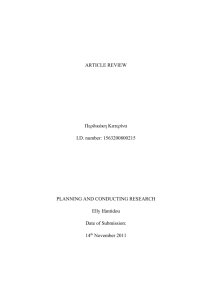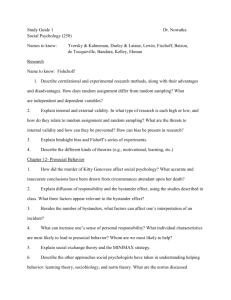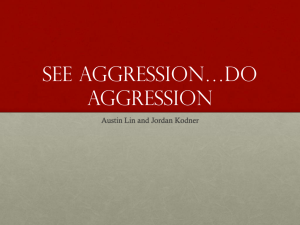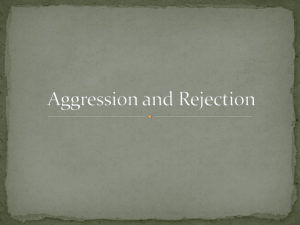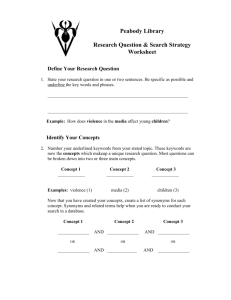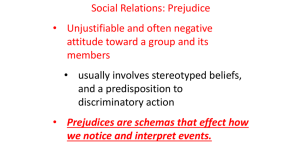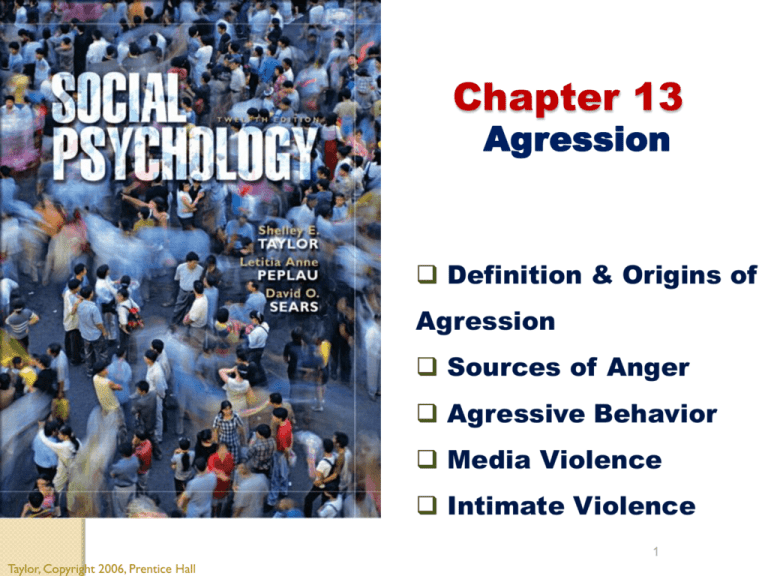
Chapter 13
Agression
Definition & Origins of
Agression
Sources of Anger
Agressive Behavior
Media Violence
Intimate Violence
1
Taylor, Copyright 2006, Prentice Hall
Aggression
Worldwide, the total number of deaths each year
1.6 million (inc.murder, suicide & war)
520,000 from homicide & 310,000 from war
Most violence committed by the people close
to us (44.4% committed by strangers)
1.6 million husbands engage in severe violence to their wives
Massive reports about parents’ violent acts against their own
children
In every 36 college women has experienced forced or unwanted
sexual intercourse.
2
Aggression- Origins of Aggression
Scientists have long debated about the origins of agression.
Freud (1930)- we have an instinct to aggress.
(Death instinct- thanatos)
Agression that may be turned inward; self-destructively or
directed outward ; toward others
Agression can be controlled but never be eliminated (natural)
3
Aggression- Origins of Aggression
Sociobiologists – evolution
Agression is an inherited tendency bec. it promotes reproductive
fitness.
Physical aggression associated with testosterone &serotonin
levels
Different patterns of brain activation
Agression tends to be stable over the life span.
Despite evidence of biological underpinnings, social factors
greatly influence the expression of aggression.
4
Aggression- Definition of Aggression
Agression; any action that is intended to hurt another.
Aggression may be antisocial, sanctioned or prosocial
Antisocial; criminal acts, violates moral standards
(Ex: husband killing his wife because of jealosy )
Prosocial; dictated by social norms, perceived as appropriate
(Ex: Police officer shooting a terrorist, parental discipline)
Sanctioned; not required by social norms but do not violate
accepted moral standard (self-defense)
(Ex: woman strikes back at rapist)
Aggression is a behavior & distinguished from feelings of anger
Overt beh. does not always reflect internal feelings.
(Someone may be quiet angry but make no effort to hurt)
5
Aggression- Sources of Anger
Most people report that they feel at least mildy or moderately
angry several times a week (Averill, 1983)
Sources of Anger;
Attacks by others
Frustration
Attack: people often respond to an attack with retaliation.
(An Eye for an eye, a tooth for a tooth) & this produces an
escalation of agression
Domestic violence often brings more domestic violence
Sometimes not one agressor & victim – mutual violence occurs.
6
Aggression- Sources of Anger
Frustration: interference with (blocking) goal attainment
When someone wants to perform some act/ obtain stg. but is
prevented from doing so, the person feels frustration.
Frustration, in turn leads to aggression
Barker et al. (1941)- effects of frustration
- Children shown a room filled with attractive toys but not allowed to
enter it.
- After the children waited for sometime they were allowed to play with
toys.
- The children who were frusturated behaved destructively (e.g.,
smashed the toys, threw them against the wall).
Family conflicts, economic insecurity, money problems,
economic depression within society, job-related problems , even
high temperatures lead to frusturation.
7
Aggression-Aggressive Behavior
What is the relationship btw. anger & aggression?
Learning to Be Aggressive
A main mechanism that determines aggression is past learning.
Aggression is influenced by both imitation & reinforcement.
Imitation; a form of learning involving thinking, feeling or
behaving in a way that matches the thoughts, feelings & beh.s of
another person.
Bandura et al. (1961) – Bobo doll experiment
peopl
- Children tend to imitate some
people more than others
liked by other
- Powerful, successful, &
liked by other people
they see
- Also, they imitate the ones
they see the most (parents)
8
Aggression-Aggressive Behavior
What is the relationship btw. anger & aggression?
Learning to Be Aggressive
Reinforcement; a major facilitator of aggression.
The process of learning a response by being rewarded when it is
demonstrated.
Parents provide both reinforcement & a model.
A child’s future aggressive beh. depends greatly on how parents
treat the child & how they themselves behave.
Ex: Children whose parents punish them for fighting tend to be less
aggressive at home but more aggressive away. (child imitates teh
parent’s aggressive beh.)
Punishment teaches him not to be aggressive at home, but also
teaches him that aggression is acceptable if he can get away
with it.
9
Aggression-Aggressive Behavior
Attributions & Chronic Aggression:
Agression remains quite stable over time.
Agression in childhood - associated with low academic
achievement, dropping out of school in adolescence, criminality
& psychopathology in adulthood.
People who are chronically aggressive have a strong
attributional bias to perceive others as acting against them with
hostile intent, especially in ambiguous situations.
Graham et al (1992) - 12-session program that trained
aggressive youths to infer non-hostile intent following ambiguous
peer provocation (Discriminate btw. İntentional &unintentional
provocation)
E.g., ask them to consider how easy it is for a ball thrown by a peer to
hit someone in the head accidentally.
- Marked reductions in part.s’ perceptions of hostile intentions & less
endorsement of aggressive beh.
10
Aggression-Aggressive Behavior
Schemas for Aggression:
Reinforcement, imitation & assumptions about others’ motives
may all combine to produce a schema for aggression
Organized interconnected beliefs about the appropriateness of
aggression, the circumstances it may occur, the way it should
be expressed etc…
Development of agression schemas- aggressive beh. İncreases
with environmental risk factors (e.g. Family violence, media
violence )
Once these schemas are in place, aggressive behaviors can be
self-perpetuating.
Schemas for aggression may vary by culture (some cultures
may have social norms dictating aggression )
11
Aggression-Aggressive Behavior
General Model of Aggressive Behavior
Anderson et al. (2002) - a model of
aggression;
Situational & personality factors- accessibility of aggression
related thoughts, affects & arousal.
These thoughts, affects & arousal influence the apprasial of the
situation & beh.
Leads to the decision whether one will aggress against the other
person.
Aggression will be most likely to occur when situational factors
combine with aggressive predispositions.
12
General
Affective
Aggression
Model
13
Aggression-Aggressive Behavior
Instrumental Aggression: a person uses aggression to obtain
a practical goal by hurting others, even when he or she is not
angry.
Ex: Boxers, paid killers injure & kill others for money, not because of
anger.
Instrumental aggression may stem from
Realistic Group Conflict.(antagonism btw.
groups arises from real conflicts of interest)
Two groups may aggress against each other
to to get those resources.
( Ex: national leaders take countries to war to
a acquire raw materials, territory etc…)
14
Aggression-Aggressive Behavior
Contagious Violence & Deindividuation: Contagious violence
& deindividuation is a form of imitative aggression.
- anonymity,
- diffusion of responsibility,
- group size,
- arousal due to noise and fatigue
Dehumanization: taking away the
personhood or human qualities of another person.
- Dehumanization played an
important role in slavery of
Blacks
15
Aggression-Reduction of Aggressive Behavior
Agression – major problem for human societies. Important to
understand how to reduce violence.
Techniques for reducing aggressive behavior;
- Punishment and Retaliation
- Learned Inhibitions
Distraction
Aggression Anxiety
Pain Cues
Alcohol and Drugs
Displaced Aggression
Catharsis
Every solution has its own risks & unintended consequences.
16
Aggression-Reduction of Aggressive Behavior
Punishment and Retaliation: Fear of punishment / retaliation
reduces aggresive beh.
If punishment is likely people avoid behaving aggresively.
Reduces aggression only in the immediate situation
(Children victims of domestic violence bec. they are less likely to retaliate)
Children who are frequently punished tend to become more
aggressive
When reached to adulthood, they are likely to abuse their
spouses
Sparks counter-aggression
17
Aggression-Reduction of Aggressive Behavior
Learned Inhibitions: learn to control aggressive urges.
People must learn aggressive beh. should be suppressed.
Factors that affect inhibition of aggression;
Distraction
Aggression Anxiety
Pain Cues
Alcohol and Drugs
Displaced Aggression
Catharsis
18
Aggression-Reduction of Aggressive Behavior
Distraction: one way to cope with anger.
Rumination increases anger
Distracting oneself from thinking about anger less likely to feed
aggressive beh.
Not always successful !
Aggression anxiety : people feel when they are about to commit
an aggressive act.
Not everyone has equal amounts of aggression anxiety
Women & children whose parents use reasoning and
withdrawal of affection (as disciplinary techniques) – higher
Pain cues : victim’s reactions
Pain cues from the victim reduce aggression
If the aggressor is extremely angry, aggression can be
intensified ( erceived as signs of successful hurting)
19
Aggression-Reduction of Aggressive Behavior
Alcohol & Drugs: Alcohol & drugs lead to disinhibition & result in
outbursts of anger.
Alcohol & drugs (e.g.; PCP, methamphetamines, crack cocaine,
but not marijuana) increase violence by reducing inhibitions
against it.
Intoxicated offenders commit 60% of the murders in U.S.A. (also
rape, robbery, domestic violence & child abuse)
Displaced Aggression: When people are
frustrated /annoyed by someone but unable to
retaliate against that person (too powerful, not
available)
Expressing aggrassion against a target other
than the original source of attack, usually a
safer target.
Ex: The child frustrated by parents pour her milk on the dog
The more similar a target is to the original source, the stronger
the aggressive impulse (should be weak & less dangerous)
20
Aggression-Reduction of Aggressive Behavior
Catharsis: When anger is released, the chance of further
aggression may be reduced.
Freud’s idea that the release of anger would reduce subsequent
aggression.
Successful in reducing aggression when an angry person
expresses that anger directly against the frustrator
But under many conditions, catharsis may actually increase
aggression
(once released we may relax our inhibitions about expressing hostility in
the future)
21
Aggression- Media Violence
Does watching violent programming have an effect on
aggressive behavior?
Theories aim to explain how & why media violence affects beh.
Learning theory – observing aggressive models teaches children
to behave violently through imitation.
Cognitive theories- children could learn aggressive scripts & be
over-quick to respond aggressively to minor insults
Ex: The bad guy provokes the good guy & the good guy retaliates.
Ind.s who have a predisposition to be aggressive especially
affected by such exposure to media violence
Much violence in media rewarded- sends the message that
learned inhibitions should be set aside.
22
Aggression- Media Violence
What does research actually find about the effects of media
violence?
Laboratory Experiments:
Generally observing televised aggression increases aggressive
behavior
Berkowitz (1974); Showed a brief film with violent physical aggression
(The Champion- Kirk Douglas)
- Participants given the oppurtunity to give electrick shocks to a
confederate
- People who viewed the violent film gave more shocks.
Causal mechanism may be that TV violence primes aggressionrelated material in memory
Bushman(1974); partcipants viewed either violent/ non-violent film
- Participants who had seen the violent film had faster reaction time to
aggressive words.
Once the associations activated, such links may set the stage for
aggressive beh.
23
Aggression- Media Violence
Laboratory Experiments; low in external validity.
Exposure to provoking conditions is brief &controlled
Little opportunity is provided for alternative responses such as
distraction.
Aggression may be measured in ways that encourage its
expression.
However, the lab studies and real-world studies agree on the
conditions under which aggression occurs:
more so after provocation,
alcohol consumption,
anonymity,
men more than women
24
Aggression- Media Violence
Correlational Research:
Focuses on longitudinal studies asking whether those
children who watch more violent TV are more aggressive as
adults.
Overall results show a modest positive correlation
Eron (1987); viewing of TV violence at age 8, predicted a variety of
aggressive beh.s at age 30.
But as with correlational research in general, there are
alternative explanations
Children who watch more TV in general more violent?
Personality characteristics as a “third variable
Field Experiments:
using experimental methods in real-world settings.
In real-life situations, observed violence seems to have fairly
weak effects on aggressive behavior.
25
Aggression- Media Violence
Recent studies; examine the effects of violence in rock music
& video games.
Anderson et al. (2003); effects of songs with violent lyrics on
aggression.
- Results of five studies; part.s who heard violent songs felt more
hostile.
Anderson & Dill (2000); violent video games increase aggressive
thoughts & behavior in the lab & are related to delinquency in the real
world (videogames lifelike).
-More so for males & for people with a prior history of aggression.
Aggressive behavior is multiply determined.
By itself, media violence is unlikely
to foster aggression.
However, media violence may contribute to
aggressive acts in some individuals
26
Aggression- Media Violence
Does watching pornography promote sexual violence?
Many researchers argue that pornography degrades women &
encourages sexual coercion & violence
A survey- assessing public reaction to sexual & violent mediamajority of (71-77%) respondents supported cencoring sexually
violate media.
Research that examines this makes a distinction between
violent & nonviolent erotica.
Violent Erotica: mixture of violence & sexual themes may
trigger unusual levels of aggression against women.
Donnerstein & Berkowitz ( 1983); participants exposed to violenterotic film.
Participants who were angered by a female (confederate) gave
more intense shocks
Violent erotic film that showed a woman enjoying the violence
provoked aggression against a woman even by men who were
not angry at her.
Seeing a nonviolent erotic film) did not provoked aggression.
27
Shock Intensity
as a function of
prior angering
and type of erotic
film
Taylor, 2006, Prentice Hall
28
Aggression- Media Violence
Exposure to violent erotica may contribute to desensitization.
Desensitization: becoming insensitive thorugh overexposure to
material that normally evokes strong emotions.
Desensitization of men to violence towards women & foster
more accepting attitudes to such violence.
Men who repeatedly exposed to violent erotic film exhibited
desensitization in terms of;
- Reducing perceptions that the material was violent
- Reducing support for equality,
- Lessening sympathy for victims of rape
Problems of external validity !
Demand characteristics in the lab situation may increase
aggression because the purpose of the study seems obvious
29
Aggression- Intimate Violence
Forms of intimate violence; Domestic violence, rape & sexual
harressment
Domestic Violence: violence committed by one family member
against another
Most common: parents abusing children, husbands abusing
wives
Children at risk; wittnessing violence associated with physical &
mental health problems (chronic stress, difficulties in school,
problems of concentration)
Sexually abused girls- biological alterations,
abnormal hormonal changes & early puberty.
30
Aggression- Intimate Violence
Factors contributing domestic violence;
Witnessing parental abuse as a child
Behaving aggressively toward children
Need to control /dominate women
Inability to empathize with other people
Also situational factors; jealousy & work –related frustration
Women assaulted by their partners experience;
- shock, denial, withdrawal, psychological numbing & fear.
- Also associated with changes in self-esteem, chronic anxiety,
fatigue, sleeping difficulties, eating disorders & nightmares.
Police are more reluctant to intervene in family violence than
stranger violence
Why do women remain?
Economic dependence, few options for escape or alternatives
31
Aggression- Intimate Violence
Factors contributing domestic violence;
Witnessing parental abuse as a child
Behaving aggressively toward children
Need to control /dominate women
Inability to empathize with other people
Also situational factors; jealousy & work –related frustration
Women assaulted by their partners experience;
- shock, denial, withdrawal, psychological numbing & fear.
- Also associated with changes in self-esteem, chronic anxiety,
fatigue, sleeping difficulties, eating disorders & nightmares.
Police are more reluctant to intervene in family violence than
stranger violence
Why do women remain?
Economic dependence, few options for escape or alternatives
32
Aggression- Intimate Violence
Rape: forced sexual activity without the partner’s consent.
Crime of aggression and power, involving a male need for
control & domination
~20% of women in the U.S. have been raped, often when
under age 18, and usually by someone they know, often by a
relative or boyfriend (current or former)
Total rapes/sexual assaults per year and the relationship of the attacker to the victim.
33
Aggression- Intimate Violence
Rape Myths may contribute to the high rates of rape
- “Women ask for it”
- Only bad girls get raped
- Any healty woman can resist a rape if she wants to
Another myth is the idea that only disturbed men rape. - However, about half of male college students said they would
force a woman to have sex against her will if they could get
away with it.
34
Aggression- Intimate Violence
Men & women have different perceptions of rape.
Muehlenhard (1988); had students evaluate scenarios;
- Men were more likely to overestimate the woman’s interest in sex and
rated the use of force as more justifiable than women did.
Men hold more rape myths than women.
Men who hold rape myths;
tolerate more violence in general,
hold more conservative sex-role stereotypes, and
exhibit hostility towards women
Rape myths create a cultural climate that is tolerant of rape
35
Aggression- Intimate Violence
Why Do Men Rape?
Sexual aggression is determined by several factors;
Hostile childhood experiences
Believing rape myths
Narcissism
Anger towards women
Need for dominance over women
Sex & aggression are linked in the minds of some men
Peer influence
Taylor, 2006, Prentice Hall
36
Aggression- Intimate Violence
Adjustment to Rape: Victims are often blamed, & may blame
themselves
Neither self-blame nor societal blame fosters good adjustment
There are long-lasting physical & psychological consequences
- STDs, pregnancies; fear, anxiety, depression
Current legal system structure may make things worse & foster
decreased reporting
37
Aggression- Intimate Violence
Sexual Harassment: includes many aggressive behaviors:
unwelcome sexual advances, verbal & physical conduct of a
sexual nature that creates a hostile and intimidating work
environment
Widespread problems in the workplace
Creates profound job, psychological, & health consequences for
those who experience it
Factors contributing to sexual harassment ;
unequal power in the workplace,
men who have an automatic link between sex and power.
The mechanisms for reporting sexual harassment appear to
encourage rather than discourage its reporting
38


